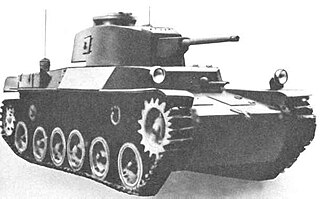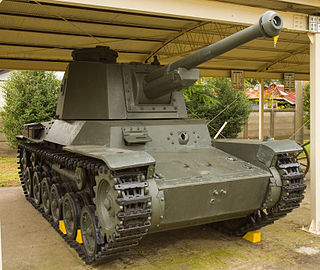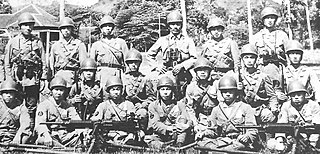
The Type 94 tankette was a tankette used by the Imperial Japanese Army in the Second Sino-Japanese War, at Nomonhan against the Soviet Union, and in World War II. Although tankettes were often used as ammunition tractors, and general infantry support, they were designed for reconnaissance, and not for direct combat. The lightweight Type 94 proved effective in China as the Chinese National Revolutionary Army had only three tank battalions to oppose them, and those tank battalions were equipped only with some British export models and Italian CV-33 tankettes. As with nearly all tankettes built in the 1920s and 1930s, they had thin armor that could be penetrated by .50 caliber (12.7 mm) machine gun fire at 600 yards (550 m) range.

The Type 97 Chi-Ha was a medium tank used by the Imperial Japanese Army during the Second Sino-Japanese War, the Battles of Khalkhin Gol against the Soviet Union, and the Second World War. It was the most widely produced Japanese medium tank of World War II.

The Special Naval Landing Forces were the marines of the Imperial Japanese Navy (IJN) and were a part of the IJN land forces. They saw extensive service in the Second Sino-Japanese War and in the Pacific theatre of World War II. The SNLF should not be confused with the Naval Landing Forces, which were primarily ad-hoc units of naval personnel formed into naval infantry units whom rarely performed proper amphibious operations and were primarily utilized in a defensive role ashore.

The Type 95 Ha-Gō was a light tank used by the Empire of Japan during the Second Sino-Japanese War, at the Battles of Khalkhin Gol against the Soviet Union, and in the Second World War. It proved sufficient against infantry but was not effective against other tanks. Approximately 2,300 were produced, making it the most numerous Japanese armoured fighting vehicle of the Second World War.
This article covers the Japanese garrisons on the by-passed Pacific islands from 1944 to 1945, including the Japanese mandated territory of the South Seas Mandate.

The Type 1 medium tank Chi-He was an improved version of the Type 97 Chi-Ha medium tanks of the Imperial Japanese Army in World War II. It had a more powerful main gun, engine and thicker armor. It was the first Japanese tank to have a communication radio as standard equipment. Production of the tank did not begin until 1943, due to the higher priority of steel allocated to the Imperial Navy for warship construction. A total of 170 units were built. All of the tanks produced were allocated for the defense of the Japanese home islands, against the anticipated Allied Invasion.

Type 3 medium tank Chi-Nu was a medium tank of the Imperial Japanese Army in World War II. Like the Type 1 Chi-He, this tank was an improved version of the Type 97 Chi-Ha. It incorporated a Type 3 75 mm tank gun, one of the largest Japanese tank guns during the war.

The Special Type 2 Launch Ka-Mi was the first amphibious tank of the Imperial Japanese Navy (IJN). The Type 2 Ka-Mi was based on the Imperial Japanese Army's Type 95 Ha-Go light tank with major modifications. It first saw combat service during the Guadalcanal campaign in late 1942.

The Type 1 Ho-Ki was a tracked armored personnel carrier (APC) developed by the Imperial Japanese Army in World War II.

The Special Type 3 Launch Ka-Chi was an amphibious medium tank developed by the Imperial Japanese Navy in World War II. The Type 3 Ka-Chi was based on an extensively modified Imperial Japanese Army Type 1 Chi-He medium tank and was a larger and more capable version of the earlier Type 2 Ka-Mi amphibious tank.

The Imperial Japanese Army (IJA) initially purchased foreign tanks for evaluation during World War I, and began developing its own indigenous designs during the late 1920s.

The Japanese marine paratroopers was a marine airborne forces during World War II. The troops were officially part of the Special Naval Landing Forces. They came from the 1st and 3rd Yokosuka SNLFs. They were under the operational control of the Imperial Japanese Navy Air Service. Rikusentai paratroopers should not be confused with the Imperial Japanese Army paratroopers, known as Teishin.

The Type 89 medium tank I-Go is a medium tank used by the Imperial Japanese Army from 1932 to 1942 in combat operations of the Second Sino-Japanese War, at Khalkhin Gol against the Soviet Union, and in the Second World War. The Type 89B model was the world's first mass-produced diesel engine tank. The tank was armed with a short-barrel 57 mm cannon for knocking out pillboxes and masonry fortifications, and proved effective in campaigns in Manchuria and China, as the Chinese National Revolutionary Army had only three tank battalions to oppose them, which consisted primarily of Vickers export models, German Panzer Is, and Italian CV33 tankettes. The Type 89 was a 1920s design medium tank, built to support the infantry, and thus lacked the armor or armament of 1940s generation Allied armor; it was regarded as obsolete by the time of the 1939 battles of Khalkhin Gol, against the Soviet Union. The code designation "I-Go" comes from the katakana letter [イ] for "first" and the kanji [号] for "number". The designation is also transliterated Chi-Ro and sometimes "Yi-Go".

The 2nd Tank Division was one of four armored divisions of the Imperial Japanese Army in World War II.

The Type 97 Shinhōtō Chi-Ha was a Japanese medium tank used in World War II that was an upgrade to the original Type 97 Chi-Ha. The new version was designated Type 97-Kai ("improved"), Shinhōtō Chi-Ha or simply "Type 97/47". Armed with a Type 1 47 mm tank gun, this design was considered to be the best Japanese tank to have seen combat service during the Pacific War. It first saw combat service at Corregidor Island in the Philippines in 1942.

This article deals with the history and development of tanks of the Japanese Army from their first use after World War I, into the interwar period, during World War II, the Cold War and modern era.

The Sumida M.2593 was an armoured car produced by the Empire of Japan in the 1930s. It could operate on both the roadway and railway lines. There were two main versions of the Sumida M.2593 made. The Type 91 armoured railroad car was used by the army and the Sumida Model P armored car was used by the Special Naval Landing Forces (SNLF) of the navy.
The 3rd Tank Regiment was an armored regiment of the Imperial Japanese Army in World War II. It served in the China/Manchuria theater throughout the war.















